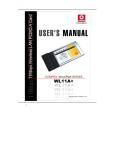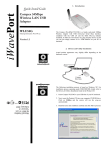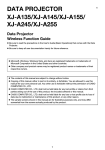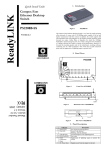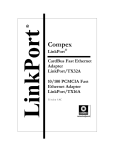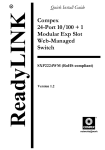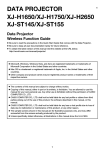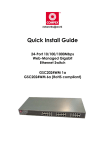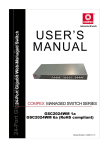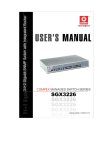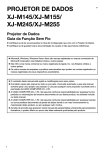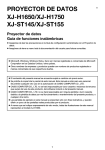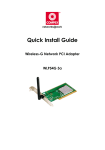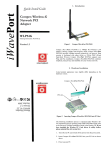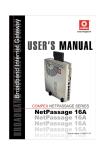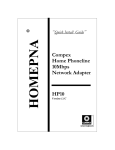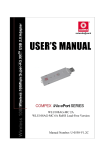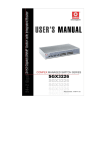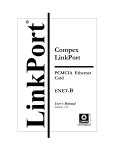Download Untitled
Transcript
Copyrights © 2001 Compex Systems Pte Ltd All Rights Reserved This document contains information, which is protected by copyright. Reproduction, adaptation or translation without prior permission is prohibited, except as allowed under the copyright laws. Trademark Information Compex®, ReadyLINK® and MicroHub® are registered trademarks of Compex, Inc. Microsoft Windows and the Windows logo are the trademarks of Microsoft Corp. NetWare is the registered trademark of Novell Inc. All other brand and product names are trademarks or registered trademarks of their respective owners. Notice: Copyrights © 2001 by Compex, Inc. All rights reserved. Reproduction, adaptation, or translation without prior permission of Compex, Inc. is prohibited, except as allowed under the copyright laws. Manual Revision by Christopher Manual Number: U-0336-V1.1C Version 1.1, December 2001 Disclaimer Compex, Inc. provides this manual without warranty of any kind, either expressed or implied, including but not limited to the implied warranties of merchantability and fitness for a particular purpose. Compex, Inc. may make improvements and/or changes to the product and/or specifications of the product described in this manual, without prior notice. Compex, Inc will not be liable for any technical inaccuracies or typographical errors found in this guide. Changes are periodically made to the information contained herein and will be incorporated into later versions of the manual. The information contained is subject to change without prior notice. Your Feedback We value your feedback. If you find any errors in this user’s manual, or if you have suggestions on improving, we would like to hear from you. Please contact us at: Telephone : Fax : Email: i (65) 3810139 (65) 2809947 [email protected] FCC NOTICE This device has been tested and found to comply with the limits for a Class B digital device, pursuant to Part 15 of the FCC Rules. These limits are designed to provide reasonable protection against harmful interference in a residential installation. This device generates, uses and can radiate radio frequency energy and, if not installed and used in accordance with the instructions, may cause harmful interference to radio communications. However, there is no guarantee that interference will not occur in a particular installation. If this device does cause harmful interference to radio or television reception, the user is encouraged to try to correct the interference by one or more of the following measures: Reorient or relocate the receiving antenna. Connect the computer into an outlet on a circuit different from that to which the receiver is connected. Increase the separation between the computer and receiver. Consult the dealer or an experienced radio/TV technician for help. Caution: Any changes or modifications not expressly approved by the grantee of this device could void the user's authority to operate the equipment. FCC Compliance Statement: This device complies with Part 15 of the FCC Rules. Operation is subject to the following two conditions: This device may not cause harmful interference, and This device must accept any interference received, including interference that may cause undesired operation. Declaration of Conformity Compex, Inc. declares the following: Product Name: Compex iWavePort 11Mbps Wireless LAN USB Adapter Model No.: WLU11A conforms to the following Product Standards: Radiated Emission Standards: EN55022A, FCC Part 15 Class B; Conducted Emission Standards: EN60555Pt2 conducted emission; EN55022A conducted emission, FCC Part 15 Class B; Immunity Standards: IEC 801-2; IEC 801-3; IEC 801-4. Therefore, this product is in conformity with the following regional standards: FCC Class B - following the provisions of FCC Part 15 directive; CE Mark - following the provisions of the EC directive. 28 December 2001 ii Technical Support Information The warranty information and registration form are found in the Quick Install Guide. For technical support, you may contact COMPEX or its subsidiaries. For your convenience, you may also seek technical assistance from the local distributor, or from the authorized dealer/reseller that you have purchased this product from. For technical support by email, write to [email protected]. Refer to the table below for the nearest Technical Support Centers: Technical Support Centers Contact the technical support center that services your location. U.S.A., Canada, Latin America and South America * Write ( Call Fax Compex, Inc. 4051 E. La Palma, Unit A Anaheim, CA 92807, USA Tel: (714) 630-7302 (8 a.m.-5 p.m. Pacific time) Tel: (800) 279-8891 ext.122 Technical Support Fax: (714) 630-6521 BBS: (714) 630-2570 (24-hour access) Europe * Write ( Call Fax ReadyLINK Networktechnology Gmbh Albert Einstein Straβe 34 / M21 63322 Rödermark, Germany Tel: +49 (0) 6074 - 98017 (8 a.m.-5 p.m. local time) Fax: +49 (0) 6074 - 90668 BBS: +49 (0) 6074 - 93974 (24-hour access) Asia, Australia, New Zealand, Middle East and the rest of the World * Write ( Call Fax Internet access/ Website: iii Compex Systems Pte Ltd 135, Joo Seng Road #08-01, PM Industrial Building Singapore 368363 Tel: (65) 286-1805 (8 a.m.-5 p.m. local time) Tel: (65) 286-2086 ext.199 Technical Support Fax: (65) 283-8337 BBS: (65) 282-8854 (24-hour access) E-mail: [email protected] FTPsite: ftp.compex.com.sg http://www.cpx.com or http://www.compex.com.sg About This Document The product described in this document, Compex iWavePort Series, WLU11A is a licensed product of Compex Systems Pte Ltd. This document contains instructions for installing, configuring and using the WLU11A. It also gives an overview of the key applications and the networking concepts with respect to the product. This documentation is for both Network Administrators and the end user who possesses some basic knowledge and expertise in the networking structure and protocols. It makes a few assumptions that the host computer has already been installed with TCP/IP and already up & running and accessing the Internet. Procedures for Windows 95/98/2000/NT operating systems are included in this document. However, for other operating system, you may need to refer to your operating system’s documentation for networking. How to Use this Document The document is written in such a way that you as a user will find it convenient to find specific information pertaining to the product. It comprises of chapters that explain in details on the installation and configuration of WLU11A. Conventions In this document, special conventions are used to help and present the information clearly. The Compex iWavePort 11Mbps Wireless LAN USB Adapter is often referred to as WLU11A in this document. Below is a list of conventions used throughout. NOTE This section will consist of important features or instructions CAUTION This section concerns risk of injury, system damage or loss of data WARNING This section concerns risk of severe injury Menu Commands, Button/Dialog Buttons, Product Indicators iv Will appear as follows in Bold Eg . Reboot System and Save Eg. MODEM 1 port or STATUS LED indicator. Table of Contents Copyrights © 2001 Compex Systems Pte Ltd............................................................ i Trademark Information .............................................................................................. i Disclaimer .............................................................................................................. i Your Feedback ........................................................................................................... i FCC NOTICE ........................................................................................................... ii Declaration of Conformity ........................................................................................ ii Technical Support Information ................................................................................ iii About This Document .............................................................................................. iv How to Use this Document ...................................................................................... iv Conventions ............................................................................................................ iv Chapter 1 1.1 1.2 1.3 1.4 1.5 1.6 Introduction .................................................................................................... 1 Overview ........................................................................................................ 1 Features and Benefits...................................................................................... 1 1.3.1 IEEE 802.11b and USB 1.1 Specifications compliant ........................ 1 1.3.2 Supports 1, 2, 5.5 and 11Mbps Data Rates.......................................... 1 1.3.3 Wired Equivalent Privacy (WEP) 64/128-bit data encryption ............ 2 Applications.................................................................................................... 2 1.4.1 When do you need wireless LAN........................................................ 2 1.4.2 Networking scenarios for WLU11A ................................................... 2 Panel Views and Descriptions ........................................................................ 4 1.5.1 Top View............................................................................................. 4 1.5.2 Front View .......................................................................................... 4 1.5.3 Panel Description ................................................................................ 5 Technical Specifications ................................................................................. 6 Chapter 2 2.1 2.2 3.3 Getting Started ..............................................................7 Package Content ............................................................................................. 7 Setup Considerations ...................................................................................... 7 2.2.1 Software requirements......................................................................... 7 2.2.2 Hardware requirements ....................................................................... 7 Chapter 3 3.1 3.2 Product Overview .........................................................1 Hardware and Software Installation...........................8 WLU11A Hardware Installation..................................................................... 8 WLU11A Driver Installation .......................................................................... 9 3.2.1 Windows 98/98SE/2000 WLU11A Driver Installation....................... 9 3.2.2 Windows XP Driver Installation Guide ............................................ 13 Configuration Utility Installation.................................................................. 16 Table of Contents 3.3.1 Windows 98,98SE, ME and Windows 2000 ..................................... 16 3.3.2 Windows XP Configuration .............................................................. 21 Chapter 4 4.1 4.2 4.3 4.4 4.5 4.6 4.7 Start the utility .............................................................................................. 22 Architecture configuration............................................................................ 23 4.2.1 Infrastructure Architecture Configuration ......................................... 26 4.2.2 Ad-Hoc Architecture Configuration.................................................. 27 Statistics........................................................................................................ 28 Site Survey.................................................................................................... 30 Security......................................................................................................... 32 4.5.1 Ad-Hoc 64-bit Encryption Configuration.......................................... 34 Advanced configuration................................................................................ 35 Version checking .......................................................................................... 37 Chapter 5 5.1 5.2 8.3 Troubleshooting ..........................................................48 Encounter IP Address Conflicts.................................................................... 48 7.1.1 For Windows 98/98SE/ME ............................................................... 48 7.1.2 For Windows 2000/XP...................................................................... 49 Chapter 8 8.1 8.2 Windows XP Wireless Connectivity..........................40 Start Windows XP Wireless Connection Properties Menu........................... 40 Windows XP Wireless Connectivity Properties Menu ................................. 43 Infrastructure Mode With 64-bit Encryption Configuration ......................... 46 Ad Hoc Mode With 128-bit Encryption Configuration ................................ 47 Chapter 7 7.1 Un-installation for Utility and drivers ......................38 To Un-install Utility ..................................................................................... 38 Drivers Un-Installation ................................................................................. 39 Chapter 6 6.1 6.2 6.3 6.4 Client Utility Configuration .......................................22 Appendix......................................................................50 Adding TCP/IP network protocol for Windows 98/98SE/ME...................... 50 Windows 98/98SE/ME Configuration of TCP/IP network protocol for DHCP server ........................................................................................................... 53 Windows XP Configuration of TCP/IP network protocol for DHCP server 55 NOTES ......................................................................................58 Chapter 1 Product Overview Chapter 1 Product Overview 1.1 Introduction Wireless network is a convenience to everyone. Whether you are a home user or an office network administrator, you are going to enjoy the benefits of the wireless network. As a home user, you can enjoy the freedom to roam around your house and maintain connection to your network. Now you can surf the web, send e-mail or download a program while in the garden or near your swimming pool. Wireless network will change the way you live. No more unsightly cables and wiring with the implementation of a wireless network. Many new offices in consideration of fast implementation and easy maintenance of the network has upgraded/expanded to a wireless network. 1.2 Overview Compex iWavePort WLU11A is a handy card-sized 11Mbps Wireless Adapter with USB (Universal Serial Bus) interface in compliant to IEEE 802.11b industry standard. It offers the convenience of a plug and play by just simply connecting to a USB interface of your PC or notebooks. 1.3 Features and Benefits Compex WLU11A is designed to give you all the supPort features you need in a wireless network to establish a wireless client. The following features are included as part of the benefits of owning a WLU11A. 1.3.1 IEEE 802.11b and USB 1.1 Specifications compliant The WLU11A can interoperate with any other wireless devices that comply with IEEE802.11b Direct Sequence Spread Spectrum (DSSS) and interpretable with most notebooks and desktop computers, in compliance to USB 1.1 specifications. 1.3.2 Supports 1, 2, 5.5 and 11Mbps Data Rates WLU11A works at a maximum speed of 11Mbps on the wireless interface; and is backward compatible to support older wireless products with lower speeds of 1, 2 Mbps. 1 Chapter 1 Product Overview 1.3.3 Wired Equivalent Privacy (WEP) 64/128-bit data encryption For data privacy, Compex iWavePort WLU11A uses a 64-bit or 128-bit private encryption key – WEP to lock your information which are transmitted over the air. Only wireless clients configured with the same WEP key will have access to the data. 1.4 Applications The Compex WLU11A facilitates wireless connections to other hosts on a network. 1.4.1 When do you need wireless LAN Installing the Compex WLU11A will be an advantage when you have the following situation: • Demanding High Mobility at your Home or Office • Where time is a scare source • Structural restriction in the building • Cost effectiveness against laying of cables • Easy scalability and expansion of existing network 1.4.2 Networking scenarios for WLU11A WLU11A can be configured for 2 types of wireless architectures – Infrastructure and Ad-Hoc. In the Infrastructure architecture, all the wireless clients communicate through the access point, which is a device that acts as a base station for all wireless communication. It is the single point of all wireless communication. The data packets from the wireless clients will be transferred to the access point before transmitting to other hosts on the network. In an Ad-Hoc architecture, the wireless clients communicate directly with one another. There is no single point of communication. No access point exists on the wireless LAN. Each wireless client transfers their data packets to the other. 2 Chapter 1 Product Overview Figure 1.4.2a shows an example of how you can use the WLU11A in an infrastructure architecture. The number of wireless clients support depends on the access point. Figure 1.4.2a Infrastructure Architecture Configuration Figure 1.4.2b shows an example of how a WLU11A can work in an Ad-Hoc architecture. In an Ad-Hoc architecture, there is no limit to the number of wireless clients you can connect. Figure 1.4.2b Ad-Hoc Architecture Configuration 3 Chapter 1 Product Overview 1.5 Panel Views and Descriptions 1.5.1 Top View 4 2 3 1 Figure 1.5.1a Top View of Compex WLU11A 1.5.2 Front View 5 Figure 1.5.2a Front View of Compex WLU11A 4 Chapter 1 Product Overview 1.5.3 1 Panel Description Name PWR LED Description Red Power is supplied to WLU11A. Off No power is supplied to WLU11A 2 RX LED Blinking Green Data is receiving on the wireless interface. Off No data is received on the wireless interface. 3 TX LED Blinking Green Data is transmitting on the wireless interface. Off No data is transmitted on the wireless interface. 4 Dipole Antenna The antenna is for RF Transmission/Receiving. 5 USB Port The connection port for your USB cable. 5 Chapter 1 Product Overview 1.6 Technical Specifications Model Industry Standards iWavePort WLU11A Interface Radio Technology Frequency Band One Type B USB interface Direct Sequence Spread Spectrum (DSSS) 2400 ~ 2483.5MHz (US, Canada) 2400 ~ 2497MHz (Europe, Japan) 4 Channels (France) 11 Channels (US & Canada) 13 Channels (Europe) IEEE 802.11 & 802.11b DSSS USB Specification v1.1 CE Mark, FCC Class B, Gost, C-Tick Operating Channels Media Access Method Data Rate Modulation Antenna Data Privacy Power Consumption Net Weight Dimension(L x W x H) Environmental Requirement Temperature Humidity 6 Carrier Sense Multiple Access with Collision Avoidance (CSMA/CA) 11Mbps, 5.5Mbps, 2Mbps, 1Mbps CCK, BPSK, QPSK Dipole Antenna 64-bit or 128-bit WEP (selectable) 5V, 250mA TX, 150mA RX, 30mA Standby About 130 g 101mm x 65 mm x 14 mm Operating : 0°C to 40°C Storage : -20°C to 70°C Operating : 10%RH to 70%RH Storage : 5%RH to 90%RH Chapter 2 Getting Started Chapter 2 Getting Started This chapter outlines the basic requirement needs before you begin any installation and configuration on the Compex WLU11A. 2.1 Package Content Thank you for purchasing the Compex WLU11A. The package should contains the following: WLU11A Adapter USB Cable Quick Install Guide with warranty card CD User manual and software drivers and utilities 2.2 • • Setup Considerations Check your Local Area Network configurations. Check if it is Dynamic or Static IP addressing. Check the TCP/IP protocols and IP address settings of the PCs/Clients or Ethernet Hub/Switch in your LAN. 2.2.1 • • Software requirements Windows 98/98SE/ME/2000/XP 2 MB of hard disk space 2.2.2 • Hardware requirements Computers with USB port that complies with USB specification 1.1 7 Chapter 3 Hardware and Software Installation Chapter 3 Hardware and Software Installation WLU11A is a Plug and Play device. You can plug into your USB port or remove it without shutting down your computer. 3.1 WLU11A Hardware Installation Figure 3.1a WLU11A Connections Before you start the hardware installation, you need to have the following items ready. • • • WLU11A unit USB cable Computer with USB port To begin 1. Power up your computer and login. 2. Plug the smaller connector of the USB cable to WLU11A and the other end the cable to your computer. 3. The PWR LED will light up indicating that WLU11A is receiving power from your computer. 4. Your computer will detect the USB device and we can proceed with the software installation next. 8 Chapter 3 Hardware and Software Installation 3.2 WLU11A Driver Installation This section is similar to the Quick Install Guide. The driver and client utility installations will be shown in following pages. 3.2.1 Windows 98/98SE/2000 WLU11A Driver Installation 1. Once you plug WLU11A into your computer, it will detect the WLU11A hardware immediately as shown in Figure 3.2.1a. Click Next > to continue. Figure 3.2.1a USB Device detection NOTE If your computer does not detect the WLU11A, check that your USB driver for your operating system is working properly. You may need to install the USB driver for computer. Please refer to the troubleshooting in chapter 7. 9 Chapter 3 Hardware and Software Installation 2. Select “Search for the best driver for your device (Recommended)” in Figure 3.2.1b and then click Next >. Figure 3.2.1b Search for new drivers 3. Insert the CD into your computer CD-ROM drive; Select “Specify a location:”, enter x:\Software\wlu11a\drivers and click Next >. (See Figure 3.2.1c) Note: x is the drive letter for your CD-ROM drive. Figure 3.2.1c Select drivers location 10 Chapter 3 Hardware and Software Installation 4. Click Next > once windows found the driver in CD drive. (See Figure 3.2.1d) Figure 3.2.1d Drivers confirmation 5. Click Next > to confirm and Windows will install the drivers as shown in Figure 3.2.1e. Figure 3.2.1e Drivers Installation 11 Chapter 3 Hardware and Software Installation 6. After Windows finish copying the files, click Finish to complete the installation. (See Figure 3.2.1f) For Windows 98/98SE/ME please reboot the system. Figure 3.2.1f Installation complete 7. Go to My Computer, use right mouse button and click on Properties. Select Device Manager then Network adapters. You will be able to find Wireless 802.11b USB Adapter if it has been successfully installed. (See Figure 3.2.1g) Figure 3.2.1g Check status of WLU11A driver 12 Chapter 3 Hardware and Software Installation 3.2.2 1. Windows XP Driver Installation Guide Power up your computer. Connect the USB male connector to your computer USB port. Your computer will detect the WLU11A hardware immediately as shown in Figure 3.2.2.a. Select “Install from a list or specific location (Advanced)”and click Next > to continue. Figure 3.2.2a Found new hardware 13 Chapter 3 Hardware and Software Installation 2. Insert the CD into your CD-ROM drive; Select “Include this location in the search:”, enter x:Software\wlu11a\drivers and click Next > as shown in Figure 3.2.2b. Windows will detect the drivers for you. Click Continue Anyway to proceed. Note: x is the drive letter of your CD-ROM drive. Figure 3.2.2b Windows logo test 3. Windows will copy the necessary files and complete the installation when Figure 3.3.2c is shown. Figure 3.3.2c Installation complete 14 Chapter 3 Hardware and Software Installation Go to My Computer, use right mouse button and click on Properties. Select Hardware and then click Device Manager. Select Network adapters. You will be able to find “Compex iWavePort WLU11A” if it has been successfully installed. (See Figure 3.2.2d) 4. Figure 3.2.2d Check status of WLU11A driver 15 Chapter 3 Hardware and Software Installation 3.3 Configuration Utility Installation 3.3.1 Windows 98,98SE, ME and Windows 2000 The Configuration Utility is required to configure your client to work with your wireless network. 1. Insert the CD into your CD-ROM drive and Windows will start Compex Product Information web page (Figure 3.3.1b). If no web is started, locate start.html at root directory of CD and double click it. (See Figure 3.3.1a) Figure 3.3.1a Locate Setup.exe 16 Chapter 3 Hardware and Software Installation 2. Locate Drivers & Utility and click it. Locate for WLU11A Configuration Utility and click it. (See Figure 3.3.1b) Figure 3.3.1b Drivers & Utility 3. If you are using Windows 98/98SE/ME/2000, select Run this program from its current location and click OK and proceed to step 5. Else skip this step.(See Figure 3.3.1c) Figure 3.3.1c Run Drivers & Utility 17 Chapter 3 Hardware and Software Installation 4. If you are using Windows XP, click Open and proceed to step 5. Else skip this step. (See Figure 3.3.1d) Figure 3.3.1d Open Drivers & Utility 5. Click Next> in the Welcome Screen as shown in Figure 3.3.1e to continue. Figure 3.3.1e Setup welcome screen 18 Chapter 3 Hardware and Software Installation 6. Select the directory to install the utility by clicking Browse… and select the various directories. To install in the default directory just click Next>. (See Figure 3.3.1f) Figure 3.3.1f Select directory to setup utility 7. Enter the name of the program folder for the utility. To use the default - just click Next>. (See Figure 3.3.1g) Figure 3.3.1g Select directory to setup utility 19 Chapter 3 Hardware and Software Installation 8. Windows will install the files from the diskette as shown in Figure 3.3.1h. Figure 3.3.1h Installing files 9. When setup finished installing the utility as shown in Figure 3.3.1i, clicks Finish to complete it. Figure 3.3.1i Installation Completion 20 Chapter 3 Hardware and Software Installation 10. Once you have completed the installation, the utility will start automatically. The utility icon will appear on the system tray once it is started. (See Figure 3.3.1j) Figure 3.3.1j Configuration & Monitor Utility 3.3.2 Windows XP Configuration Windows XP configuration, please refer to Windows XP Wireless Connectivity Properties for Windows XP Software. (Refer page 40 for the setup). 21 Chapter 4 Client Utility Configuration Chapter 4 Client Utility Configuration The client utility you have just installed allows you to configure WLU11A easily without having to reboot your operating system. 4.1 Start the utility There are various ways you can start the configuration utility in Windows 98/98SE/2000/XP You can start the utility from the Windows Start menu, select Programs folder and then select Wireless 802.11 USB Utility folder and click WLAN Monitor Utility. Figure 4.1a Start Configuration & Monitor Utility You can also start the utility by clicking the Utility icon on the system tray as shown in Figure 3.3.1j. 22 Chapter 4 Client Utility Configuration 4.2 Architecture configuration WLU11A can be configured to work in Infrastructure or Ad-Hoc architecture mode. For more information about Infrastructure or Ad-Hoc architecture, please refer to section 1.4.2. To configure the Architecture do the following: 1. Start the client utility. Click Status menu and the following screen will be shown in Figure 4.2a. Figure 4.2a Start Configuration & Monitor Utility 23 Chapter 4 Client Utility Configuration Before we continue the various parameters on Status menu are explained in Table 4.2 below. Parameters Description Operating mode Select the Ad-Hoc or Infrastructure architecture for your wireless network. Values Infrastructure There is an access point in the wireless network. Ad-Hoc There is no access point in the wireless network. Channel Select the frequency channel for your wireless network client. Values 1 to 4 channels France 1 to 11 channels United States & Canada (FCC) 1 to 13 channels European, except France (ETSI) SSID Tx Rate Power Mgmt Mode SSID is the acronym for Service Set Identifier. It is a unique name that is shared among all wireless hosts. Key in an Identification to specify the wireless network you want to access. Set the transfer rate for the wireless interface. If the transfer rate for your wireless interface cannot be sustained, the link will be dropped. If you set the Tx Rate to Auto, WLU11A will adjust the transfer rate depending on the Link distance. Values 1 Mbps, 2 Mbps, 5.5 Mbps, 11 Mbps, Auto. To enable power saving for WLU11A select Power Save else select Active. Values Power Save, Active NOTE Power Save mode can only work in Infrastructure mode. Table 4.2 Status Menu Parameters 24 Chapter 4 Client Utility Configuration Parameters Description MAC Address Shows the MAC address of your WLU11A. Status Shows the various status of wireless connection Values Changing configuration… Utility is updating information to WLU11A. Scanning… WLU11A is scanning for any available wireless network. OK… WLU11A detects other wireless clients in Ad-Hoc mode. Associated – BSSID:… WLU11A is connected to an Access Point in Infrastructure mode. The BSSID is shown in HEX numbers. Signal Strength Indicates the signal strength of data packets from the access point in infrastructure mode. Link Quality Values 0 to 100% Indicates the signal quality of the link to other wireless hosts. Values 0 to 100% Table 4.2 Status Menu Parameters (Continue) 25 Chapter 4 Client Utility Configuration 4.2.1 1. Infrastructure Architecture Configuration Start the client utility. Click Status menu and then click Change and configure the following parameters. Operating Mode: Infrastructure SSID: Compex Tx Rate: Auto Power Mgmt Mode: Active Figure 4.2.1a Example of Infrastructure Mode 2. Click Submit and WLU11A will search for any access point. 3. Click Exit to close the program. NOTE All the information entered must be the same value as your access point in order for WLU11A to connect to it. 26 Chapter 4 Client Utility Configuration 4.2.2 1. Ad-Hoc Architecture Configuration Start the client utility. Click Status menu and then click Change and configure the following parameters. Operating Mode: Ad-Hoc Channel: 3 SSID: Compex Tx Rate: Auto Power Mgmt Mode: Active Figure 4.2.2a Example of AdHoc Mode 2. Click Submit and WLU11A will search for any wireless clients. 3. Click Exit to close the program. NOTE All the information entered must be the same value as your other wireless clients in order for WLU11A to connect to them. 27 Chapter 4 Client Utility Configuration 4.3 Statistics After you have configured the desired architecture, WLU11A can show you the statistics for transmission. To watch the statistics, follow the procedures below: 1. Start the client utility. Click Statistics menu and the following Figure 4.3a will be shown. Figure 4.3a Statistics menu 28 Chapter 4 Client Utility Configuration Table 4.3 explains the various parameters on the Statistics Menu. Parameters Data Successful Tx/Rx Unsuccessful Tx/Rx Description The number of data packets successfully transmitted or received. The number of data packets unsuccessfully transmitted or received. Management Successful Tx/Rx The number of management transmitted or received. Unsuccessful Tx/Rx The number of management packets unsuccessfully transmitted or received. Rejected packets TX/RX Number of rejected transmitted/received packets Table 4.3 Statistic Menu Parameters 29 packets successfully Chapter 4 Client Utility Configuration 4.4 Site Survey The Site Survey shows the wireless hosts that are detected by WLU11A. To check the wireless hosts around WLU11A do the following. 1. Start the client utility. Click Site Survey menu and the following Figure 4.4a will be shown. Figure 4.4a Site Survey Menu 2. 30 To scan the wireless hosts click Re-Scan. During the scanning, you can end it by clicking Cancel. Chapter 4 Client Utility Configuration Table 4.4 explains the various parameters on the Site Survey Menu. Parameters Description BSSID A hex number that identifies the wireless host. SSID SSID is the acronym for Service Set Identifier. It is a unique name that is shared among all wireless hosts in the same wireless network. Signal Shows the signal strength to the device. Channel The frequency channel that is set on the respective wireless host. Encryption Shows whether Encryption is turned on or off on the respective wireless host. BSS BSS is the acronym for Basic Service Set. It indicates the mode (Infrastructure or Ad-Hoc) this BSSID is working in. Table 4.4 Site Survey Menu Parameters 31 Chapter 4 Client Utility Configuration 4.5 Security As air is the medium of transmission, any users with a wireless enabled computer can eardrop the data transmitted easily. For protection of your data from unauthorized users, you need to encrypt the data before they are transmitted. WLU11A offers two types of encryption – 64-bit WEP and 128-bit WEP. To secure your data do the following: 1. Start the client utility. Click Encryption menu and select 64 bit under Encryption parameters and the following Figure 4.5a will be shown. Figure 4.5a Encryption Menu 32 Chapter 4 Client Utility Configuration Table 4.5 explains the various parameters on the Encryption Menu. Parameters Description Encryption Select Disabled, 64 bit or 128 bit WEP encryption. Values Disabled Encryption is disabled. 64 bit: You need to key in 10 Hex numbers for your secret key to encrypt the data transmitted. Each key needs to have 10 Hex numbers. KEY#1 KEY#2 KEY#3 KEY#4 128 bit You need to key in 26 Hex numbers for your secret key to encrypt the data transmitted. Each key needs to have 26 Hex numbers. Enter your Encryption Key here. NOTE You can enter up to 4 Encryption Key. However, only 1 key will be used at a time. Default Key Select one of the four keys to use for encryption. Mode Select the mode for the encryption key Values Optional Encryption key does not depend on the Encryption key selected. Authentication Type Mandatory Encryption also depends on the Encryption key selected. Select how the wireless client authenticate with the access point. Values Open system Wireless client does not need to share the same Encryption key to authenticate with access point. Shared Key Wireless client need to share the same Encryption key to authenticate with access point. Table 4.5 Site Survey Menu Parameters 33 Chapter 4 Client Utility Configuration 4.5.1 1. Ad-Hoc 64-bit Encryption Configuration Start the client utility. Click Encryption menu and configure the following parameters. Encryption 64 bit Key #1 0123456789 Key #2 ABCDEF0000 Key #3 0000000000 Key #4 0000000000 Default Key Key #1 Mode Mandatory Authentication Type Open System Figure 4.5.1a 64-bit Encryption Configuration 2. Click Submit for changes to take effect. NOTE All the information entered must be the same value as that of your wireless network in order for WLU11A to connect to it. 34 Chapter 4 Client Utility Configuration 4.6 Advanced configuration The Advanced configuration menu is for users who are familiar with the IEEE802.11 standard. Preamble type, Fragmentation Threshold and RTS/CTS Threshold can be set here. To set these setting do the following: 1. Start the client utility. Click Advanced menu and the following Figure 4.6a will be shown. Figure 4.6a Advanced Menu 35 Chapter 4 Client Utility Configuration Table 4.6 explains the various parameters on the Advanced Menu. Parameters Description Preamble Type Select Long or Short Preamble for the length of the preamble Values Long 144 bits. Short 72 bits Auto Automatically select Long or Short for Preamble type. Fragmentation Threshold RTS/CTS Threshold Set the maximum size the RF data packet will be split up for transmission. Values 256 to 2345 2346 to disable. Set the size of the Request to Send (RTS) and Clear to Send (CTS) packets. Values 1 to 2346 2347 to disable. Table 4.6 Advanced Menu Parameters 36 Chapter 4 Client Utility Configuration 4.7 Version checking Check the version of your Driver, firmware and Application here. You can download the newer version on Compex web site at www.compex.com.sg or www.cpx.com. To check the version of your WLU11A do the following: 1. Start the client utility. Click Version menu and the following Figure 4.7a will be shown. Figure 4.7a Version Menu Table 4.7b explains the various parameters on the Version Menu. Parameters Driver Version Firmware Version Application Version 37 Description The version of the driver used. The version of the firmware in WLU11A. The version of the Client Utility. Table 4.7b Version Menu Parameters Chapter 5 Un-installation for drivers and Utility Chapter 5 Un-installation for Utility and drivers This chapter provides instructions for you to un-install the drivers and utility. 5.1 To Un-install Utility If you want to install a new client utility, you need to un-install the present client utility first. 1. Start the Uninstall; Select Programs folder and then select Wireless 802.11 USB Utility folder and click Uninstall. Click OK to continue. Figure 5.1a InstallShield Wizard 2. Once the following screen (Figure 6.1b) is shown, the un-installation process is completed. Click Finish to close it. Figure 5.1b Maintenance Complete 38 Chapter 5 Un-installation for drivers and Utility 5.2 Drivers Un-Installation If the drivers are corrupted, you can remove the drivers by following the procedures below. 1. Search for the Un98wlua.bat file in the CD-ROM under the directory software/wlu11a/drivers and Run it. Figure 5.2a Un98wlua.bat NOTE This batch file only works for Windows 98/98SE and ME. 2. A Dos batch will run. Press Enter key twice to uninstalled the drivers. Figure 6.2b shows the results of the un-installation. Figure 6.2b Uninstallation successful 39 Chapter 6 Windows XP Wireless Connectivity Chapter 6 Windows XP Wireless Connectivity Windows XP comes with the support for wireless Network. You can use Windows XP Wireless Connectivity to connect your WLU11A to your wireless network. 6.1 1. Start Windows XP Wireless Connection Properties Menu Once you have installed the drivers for WLU11A, Windows XP will detect WLU11A and a Wireless Network Connection icon will be seen on the system tray. Click it.(See Figure 6.1a) Figure 6.1a Wireless Network Connection icon 2. If wireless client is not connected to any wireless network Figure 6.1b will be shown else Figure 6.1c will be shown. Figure 6.1b Connect to Wireless Network 40 Chapter 6 Windows XP Wireless Connectivity Figure 6.1c Wireless Network Connection Status 3. 41 Click Advanced if Figure 6.1b is started else click Properties if Figure 6.1c is started. Wireless Network Connection Properties – Wireless Networks will be started as shown in Figure 6.1d. Chapter 6 Windows XP Wireless Connectivity Figure 6.1d Wireless Network Connection Properties – Wireless Networks 42 Chapter 6 Windows XP Wireless Connectivity 6.2 Windows XP Wireless Connectivity Properties Menu The properties of the Wireless Network Connection Properties Menu will be explained in this section. Figure 6.2a shows the hierarchy of the other menus. The various buttons will bring you to the various menus as shown in Figure 6.2a. Figure 6.2a Hierarchy of Various Other Menus 43 Chapter 6 Windows XP Wireless Connectivity Table 6.2a explains the various parameters on the Wireless Network Connection Properties Menu. Parameters Description Use Windows to configure my wireless network settings Available Networks Preferred Networks Specify whether to use Windows wireless Connection or WLU11A utility to configure WLU11A. Display the wireless network detected by WLU11A. Configure the priority of wireless network to connect to WLU11A. Table 6.2a Wireless Network Connection Properties Menu Parameters Table 6.2b explains the various parameters on the Advanced Menu. Parameters Description Networks to access Specify the priority on the types of wireless network the wireless client is to be connected. Automatically connect to non-preferred networks Specify whether to connect to wireless network that are not specified in the preferred networks. Table 6.2b Advanced Menu Parameters 44 Chapter 6 Windows XP Wireless Connectivity Table 6.2c explains the various parameters on the Wireless Network Properties Menu. Parameters Description Network name(SSID) SSID is the acronym for Service Set Identifier. It is a unique name that is shared among all wireless hosts in the same wireless network. Data encryption enabled) (WEP Specify whether to use Encryption when connecting to wireless network. Network Authentication (Shared mode) Specify whether wireless client use Open system or Shared Mode to authenticate to an Access Point. Open system Wireless client does not need to share the same Encryption key to authenticate with access point. Network key Shared Key Wireless client need to share the same Encryption key to authenticate with access point. Enter your Encryption Key here. Key format The format of the encryption key. Values ASCII characters Hexadecimal digits Key Length Key index The key is provided for me automatically This is a computer-tocomputer (ad hoc) network; wireless access points are not used Specify whether to use 64-bit or 128-bit encryption. Specify the location of the of the Network key. Specify whether to use the Encryption key is automatically provided by the preferred network. Specify whether to set this network for ad-hoc or Infrastructure mode. Infrastructure There is an access point in the wireless network. Ad-Hoc There is no access point in the wireless network. Table 6.2c Wireless Network Connection Menu Parameters 45 Chapter 6 Windows XP Wireless Connectivity 6.3 Infrastructure Mode With 64-bit Encryption Configuration 1. Start Windows XP Wireless Connectivity Properties Menu, click Add and enter the following information. Network name(SSID): Compex Data encryption (WEP enabled): R Network mode): Authentication (Shared * Network key: 1122334455 Key format: Hexadecimal digits Key length: 40 bits(10 digits) Key index (advanced): 0 The key is provided automatically: for me * This is a computer-to-computer (ad hoc) network; wireless access points are not used * 2. Click OK and then click Refresh to let WLU11A search for your preferred wireless network. NOTE All the information entered must be the same value as your access point in order for WLU11A to connect to it. 46 Chapter 6 Windows XP Wireless Connectivity 6.4 Ad Hoc Mode With 128-bit Encryption Configuration 1. Start Windows XP Wireless Connectivity Properties Menu, click Add and enter the following information. Network name(SSID): Compex Data encryption (WEP enabled): R Network mode): Authentication (Shared * Network key: 11223344556677889900aabbcc Key format: Hexadecimal digits Key length: 104 bits(26 digits) Key index (advanced): 0 The key is provided for automatically: me * This is a computer-to-computer (ad hoc) network; wireless access points are not used R 2. Click OK and then click Refresh to let WLU11A search for your preferred wireless network. NOTE All the information entered must be the same value as your other wireless clients in order for WLU11A to connect to them. 47 Chapter 7 Troubleshooting Chapter 7 Troubleshooting This chapter explains how to perform some basic troubleshooting when you encounter problems while installing the Compex WLU11A. 7.1 Encounter IP Address Conflicts In the process of configuring the WLU11A in network with a DHCP server, you may encounter a conflict of IP address as shown. Figure 7.1a IP conflict 7.1.1 For Windows 98/98SE/ME In Windows 95/98, you can try the following to release your IP address and renew a new IP address: 1. Click Start, point to Run, and enter in winipcfg. The Winipcfg screen will then appear as shown. Click Release All button. The Winipcfg will then release your current TCP/IP configuration to 0.0.0.0. Figure 7.1.1a Winipcfg program 2. 48 Click OK. Chapter 7 Troubleshooting 3. And Restart your computer. 7.1.2 For Windows 2000/XP Do the following 1. 2. At the Command Prompt, type ipconfig /release and press [Enter]. Next, type ipconfig /renew and press [Enter].(See Figure 7.12a) Figure 7.1.2a ipconfig command 49 Chapter 8 Appendix Chapter 8 Appendix This chapter provides some additional information that may be useful to you when setting up the WLU11A. Basic Networking configurations for network adapters are covered here. The configurations here assumed that a DHCP server exist in your network. 8.1 1. Adding TCP/IP network protocol for Windows 98/98SE/ME From the Windows 98/98SE/ME Start Button, select Settings, and then Control Panel. 2. Double-click on the Network icon and a Network screen will appear as: Installed Components Look for TCP/IP Add button Figure 8.1a Network Configuration 50 Chapter 8 Appendix 3. Check your list of Network Components in the Network window Configuration tab. If TCP/IP is not installed, select Add button to start the installation 4. Select Protocol and click Add button. Figure 8.1b Select Network Component Type 5. Select Microsoft and TCP/IP in Manufacturers and Network Protocols columns respectively. Click OK. You may need your Windows CD to complete the installation. Figure 8.1c Select Network Protocol 6. 51 After TCP/IP is installed, go back to the Network screen and select TCP/IP in the list of Network Components. Chapter 8 Appendix 7. Click Properties, and check the settings in each of the TCP/IP Properties window. TCP/IP Properties Tabs (IP address Tab shown) Figure 8.1d IP Address Configuration Now that you have your TCP/IP installed, you may proceed to section 7.2 to configure the TCP/IP. 52 Chapter 8 Appendix 8.2 Windows 98/98SE/ME Configuration of TCP/IP network protocol for DHCP server 1. Click on IP Address Tab and select Obtain an IP address automatically. Figure 8.2a IP Address Configuration 2. Click on Bindings Tab and select Client for Microsoft Networks and File and printer sharing for Microsoft Networks, and click OK Figure 8.2b Binding 53 Chapter 8 Appendix 3. Click the Gateway and make sure all fields are blank. Figure 8.2c Gateway 4. Click on DNS Configuration Tab and select Disable DNS Figure 8.2c Gateway 54 Chapter 8 Appendix 5. Click OK to accept these settings and reboot the PC. 8.3 Windows XP Configuration of TCP/IP network protocol for DHCP server For Windows XP, you do not need to install the TCP/IP protocol as it is installed when you install a network card. Therefore only the configuration for TCP/IP is shown. 1. From the Windows XP Start menu - click Control Panel, then click Network and Internet Connections. Then click Network Connections to open Figure 8.3a below. Figure 8.3a Network Connections 55 Chapter 8 Appendix 2. Right click the network connections you want to edit and click Properties. Figure 8.3b will be opened as shown. Figure 8.3b WLU11A Network Connection 56 Chapter 8 Appendix 3. Highlight the Internet Protocol (TCP/IP) item and click Properties. Figure 8.3c will be shown. Figure 8.3c IP Address Configuration 4. Select “Obtain an IP address automatically” and click OK. To be able to browse the Net, the PC usually runs a browser. If you have not installed any, install one now. The most popular browsers are Microsoft Internet Explorer and Netscape. Start the browser and the NP11A will connect these PCs to the Internet. 57 NOTES 58

































































